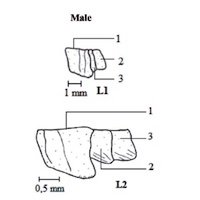Morphology, development and reproduction of Atractomorpha acutipennis (Guérin-Méneville, 1844) (Orthoptera: Pyrgomorphidae)

HTML: 59
All claims expressed in this article are solely those of the authors and do not necessarily represent those of their affiliated organizations, or those of the publisher, the editors and the reviewers. Any product that may be evaluated in this article or claim that may be made by its manufacturer is not guaranteed or endorsed by the publisher.
Authors
For a better knowledge of Atractomorpha acutipennis bio-ecology and to facilitate its identification, we studied the morphology, development and reproduction of this grasshopper on Manihot esculenta under laboratory conditions. Five hundred and fifty-one first nymphal stages obtained in the laboratory were reared in cages. Some body parts allowed a clear identification of different nymphal instars. Post-embryonic development passed through six stages (males) and seven stages (females). Mean nymphal development time was 17.14 ± 0.62, 12.91 ± 0.62, 13.45 ± 0.69, 13.80 ± 0.68, 15.23 ± 0.55 days respectively in males nymphal instars 1 to 5 and 16.18 ± 0.54, 13.13 ± 0.59, 12.49 ± 0.42, 13.19 ± 0.58, 14.58 ± 0.61, 16.57 ± 0.68 days respectively, in females nymphal instars 1 to 6. Adult females deposited an average of 3.67 ± 2 egg pods each comprising 30.77 ± 10.5 eggs. First mating was observed 18 ± 15.42 days after the last moult. Oviposition occured on average 19.33± 5.33 days after the first mating. This study provides important information about the biology of A. acutipennis, which could help in developing control methods against this grasshopper in southern Cameroon.
How to Cite
PAGEPress has chosen to apply the Creative Commons Attribution NonCommercial 4.0 International License (CC BY-NC 4.0) to all manuscripts to be published.


 https://doi.org/10.4081/tz.2020.81
https://doi.org/10.4081/tz.2020.81



